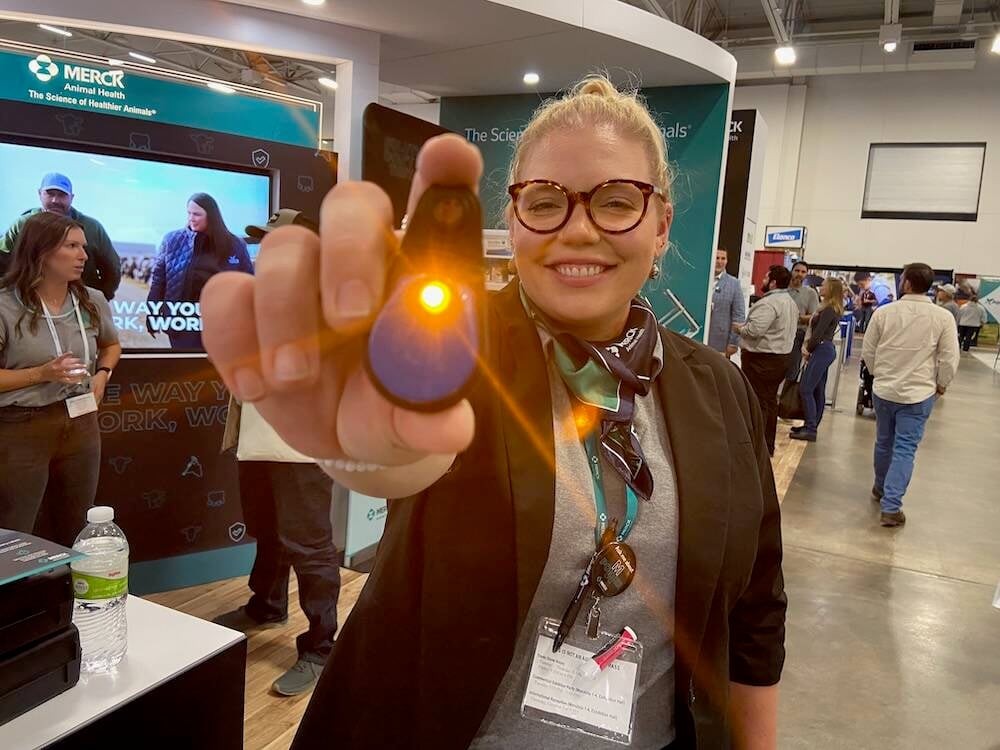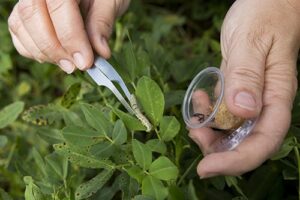
51330 web1 Erica Tessman Merck World Dairy Expo jg.jpeg
Dairy calf monitoring options are exploding as companies develop smaller, wearable sensors and new algorithms.
Read Also
Artificial intelligence that can learn has been critical to this development. Compared to monitoring the steady state of adult cows, growing calves change rapidly and the sensors have to accommodate that.
The goal is to give farmers greater ability to diagnose calf problems before they become clinical.
Why it matters: Replacement heifers are a large expense for dairy farmers and if they contract a disease as calves, it can have major effects on milking cow productivity.
Numerous companies touted their calf monitoring solutions at the recent World Dairy Expo and several of the 25 innovation winners at Eurotier this fall are calf monitoring technologies. (See page 16 for more information on these.)
Merck Animal Health’s SenseHub Youngstock monitors calves, but the ear tag also illuminates with an LED light if the calf needs attention. That makes it easy for workers to see which calf they need to check.
Erica Tessmann, marketing manager of dairy monitoring for Merck Animal Health, says the company’s SenseHub technology is proven in dairy cows, but there was a lack of data for calves.
“This is really going to expand our ability to monitor animals from birth instead of from first lactation,” she says.
The calf ear tag is the same tag that goes in dairy or beef cattle, and must be installed properly if it’s to last through the cow’s life. The difference between the cow and calf products is the algorithms that support the sensors.
SenseHub Youngstock tracks activity levels and suckling behaviour based on ear movement as the calf drinks. Some sound indicators are also tracked.
“What we really want to see is consistency in activity and consistency in suckling behaviour,” says Tessmann.
Like all ear-based calf sensors, once the tag is installed, it can be used for the rest of the calf’s life. Companies expect their tags to last seven to 10 years.
CalfManager
CowManager is gradually rolling out its CalfManager ear tag monitoring system worldwide. The CalfManager monitor measures similar data to the company’s cow tag, including rumination, activity, lying, eating and temperature.
“Whenever that calf joins us on this earth, she has a certain potential to become a sort of dairy cow. Every instance of disease, it could be an infection, it could be diarrhea, it could be pneumonia, every instance of disease nibbles away at that,” says Tom Stigter, CowManager’s account manager for North and South America.
Identifying a health event before it becomes clinical is critical and that’s what the tag does.
It is a challenge to build an algorithm specific for calves because they change rapidly in their first year of life. Eating habits and movements change as they grow. Cow eating time is predictable and a variation is a trigger for observation.
“In calves, it’s the opposite,” says Stigter. “They are developing their rumen, they are developing their behaviour, so your algorithm has to grow along with that calf.”
The tag is installed in the calf’s ear at about 14 days or 110 pounds. It has been tested in Europe and will be available around the company’s Wisconsin North American base by the end of the year. It is expected to be available across Canada and the United States in 2025.
Smart Tag Ear
Nedap has also moved its cow monitoring system to younger animals, but so far, it’s for heifers at about one year old.
Tera Baker, Nedap’s marketing manager for North America, said at the World Dairy Expo that the critical element is to monitor heifers for their first breeding service. The sensor is also ear-based, as the company has evolved from a collar-based system.
The sensor will supply heifer rumination, eating time and activity information.
The Smart Tag Ear product will be available in January from Nedap’s distribution partners.
Other developments
Other companies are supplying more data in the calf area. Forster Technik won a gold award at Eurotier for its new CalfGPT, a system that uses artificial intelligence to enable a farmer to use voice commands to request information about a calf as well as to input information. Urban, a maker of automated milk feeders, has increased the sensors in its feeders to provide more information on drinking and swallowing behaviour, which can also be linked to health issues.
As the cost of replacement cows continues to rise, the value of calf data should also increase and new data harvesting options can link calf events to cow effects.
Source link
2024-11-07 15:28:29
Karl Hoffman is a distinguished agriculturalist with over four decades of experience in sustainable farming practices. He holds a Ph.D. in Agronomy from Cornell University and has made significant contributions as a professor at Iowa State University. Hoffman’s groundbreaking research on integrated pest management and soil health has revolutionized modern agriculture. As a respected farm journalist, his column “Field Notes with Karl Hoffman” and his blog “The Modern Farmer” provide insightful, practical advice to a global audience. Hoffman’s work with the USDA and the United Nations FAO has enhanced food security worldwide. His awards include the USDA’s Distinguished Service Award and the World Food Prize, reflecting his profound impact on agriculture and sustainability.



